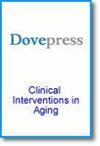Development and Validation of a New Nomogram Model for Predicting Acute Ischemic Stroke in Elderly Patients with Non-Valvular Atrial Fibrillation: A Single-Center Cross-Sectional Study
IF 3.7
3区 医学
引用次数: 0
Abstract
Background and Aims: Non-valvular atrial fibrillation (NVAF) patients face a 3– 5 times greater risk of acute ischemic stroke (AIS) compared to those without NVAF. This study aims to establish a novel clinical prediction model for AIS in elderly patients with NVAF by incorporating relevant biomarker indicators.Methods: A total of 301 individuals diagnosed with NVAF were selected for this investigation at the Third Affiliated Hospital of Anhui Medical University. Based on the presence of AIS, patients were categorized into two groups: the Stroke Cohort and the Non-Stroke Cohort. Predictor screening was performed using the least absolute shrinkage and selection operation (LASSO) regression algorithm. The binary logistic regression equation was applied to fit the model, followed by internal validation using the bootstrap resampling method (1000 times). Receiver operating characteristic (ROC) curve, calibration degree curve plots, and clinical decision curve analysis (DCA) were generated, respectively. Finally, a nomogram was constructed to present the prediction model.
Results: The final results of this study revealed that neutrophil-to-lymphocyte ratio (NLR), red cell distribution width (RDW), lipoprotein(a) (Lp(a)), systolic pressure, history of stroke, hyperlipidemia were independent risk factors for AIS in elderly patients with NVAF (P< 0.05). And the high-density lipoprotein cholesterol (HDL-C) was an independent protective factor (P< 0.05). By incorporating these indicators, a nomogram prediction model for predicting AIS in elderly patients with NVAF was constructed. Comparative analysis between the nomogram predictive model and CHA2DS2-VASc score revealed that the AUC of the nomogram predictive model surpassed that of the CHA2DS2-VASc score (AUC: 0.881vs 0.850).
Conclusion: NLR, RDW, Lp(a), SP, history of stroke, hyperlipidemia, and HDL-C emerge as independent prognostic factors for acute ischemic stroke in elderly patients with non-valvular atrial fibrillation. The predictive utility of the nomogram model may potentially surpass that of the CHA2DS2-VASc scoring system.
Keywords: acute ischemic stroke, non-valvular atrial fibrillation, nomogram, clinical risk prediction model
开发并验证用于预测老年非瓣膜性心房颤动患者急性缺血性卒中的新提名图模型:单中心横断面研究
背景和目的:非瓣膜性心房颤动(NVAF)患者发生急性缺血性卒中(AIS)的风险是无NVAF患者的3-5倍。本研究旨在结合相关生物标志物指标,建立一个新型的老年 NVAF 患者 AIS 临床预测模型:方法:本研究在安徽医科大学第三附属医院选取了 301 例确诊为 NVAF 的患者。根据是否存在 AIS,将患者分为两组:脑卒中队列和非脑卒中队列。预测因子筛选采用最小绝对缩小和选择操作(LASSO)回归算法。应用二元逻辑回归方程拟合模型,然后使用引导重采样法(1000 次)进行内部验证。分别生成了接收者操作特征曲线(ROC)、校准度曲线图和临床决策曲线分析(DCA)。最后,构建了一个提名图来呈现预测模型:研究最终结果显示,中性粒细胞与淋巴细胞比值(NLR)、红细胞分布宽度(RDW)、脂蛋白(a)(Lp(a))、收缩压、卒中史、高脂血症是老年 NVAF 患者发生 AIS 的独立危险因素(P< 0.05)。而高密度脂蛋白胆固醇(HDL-C)是一个独立的保护因素(P< 0.05)。通过纳入这些指标,构建了预测老年 NVAF 患者 AIS 的提名图预测模型。提名图预测模型与 CHA2DS2-VASc 评分的比较分析表明,提名图预测模型的 AUC 超过了 CHA2DS2-VASc 评分(AUC:0.881vs 0.850):结论:NLR、RDW、脂蛋白(a)、SP、卒中史、高脂血症和高密度脂蛋白胆固醇是非瓣膜性心房颤动老年患者急性缺血性卒中的独立预后因素。提名图模型的预测效用有可能超过 CHA2DS2-VASc 评分系统。
本文章由计算机程序翻译,如有差异,请以英文原文为准。
求助全文
约1分钟内获得全文
求助全文
来源期刊

Clinical Interventions in Aging
GERIATRICS & GERONTOLOGY-
CiteScore
6.20
自引率
2.80%
发文量
193
期刊介绍:
Clinical Interventions in Aging, is an online, peer reviewed, open access journal focusing on concise rapid reporting of original research and reviews in aging. Special attention will be given to papers reporting on actual or potential clinical applications leading to improved prevention or treatment of disease or a greater understanding of pathological processes that result from maladaptive changes in the body associated with aging. This journal is directed at a wide array of scientists, engineers, pharmacists, pharmacologists and clinical specialists wishing to maintain an up to date knowledge of this exciting and emerging field.
 求助内容:
求助内容: 应助结果提醒方式:
应助结果提醒方式:


